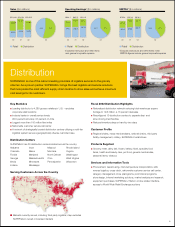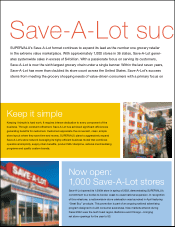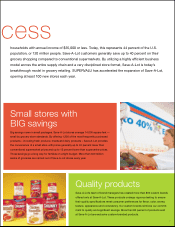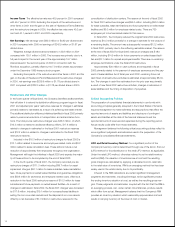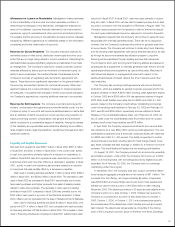Albertsons 2002 Annual Report Download - page 17
Download and view the complete annual report
Please find page 17 of the 2002 Albertsons annual report below. You can navigate through the pages in the report by either clicking on the pages listed below, or by using the keyword search tool below to find specific information within the annual report.
Allowances for Losses on Receivables Management makes estimates
of the uncollectibility of its accounts and notes receivable portfolios. In
determining the adequacy of the allowances, management analyzes the
value of the collateral, customer financial statements, historical collection
experience, aging of receivables and other economic and industry factors.
It is possible that the accuracy of the estimation process could be materially
impacted by different judgments as to collectibility based on the information
considered and further deterioration of accounts.
Reserves for Closed Properties The Company maintains reserves for
estimated losses on retail stores, distribution warehouses and other prop-
erties that are no longer being utilized in current operations. Calculating the
estimated losses requires significant judgments and estimates to be made
by management. The Company’s reserves for closed properties could be
materially affected by factors such as the extent of interested buyers, its
ability to secure subleases, the creditworthiness of sublessees and the
Company’s success at negotiating early termination agreements with
lessors. These factors are significantly dependent on the general health of
the economy and resultant demand for commercial property. While man-
agement believes the current estimates of reserves on closed properties
are adequate, it is possible that changes in events could cause changes in
the Company’s assumptions, requiring additional reserves to be recorded.
Reserves for Self Insurance The Company is primarily self-insured for
workers’ compensation and general and automobile liability costs. It is the
Company’s policy to record its self insurance liabilities based on claims filed
and an estimate of claims incurred but not yet reported. Any projection of
losses concerning workers’ compensation and general and automobile
liability is subject to a considerable degree of variability. Among the causes
of this variability are unpredictable external factors affecting future inflation
rates, litigation trends, legal interpretations, benefit level changes and claim
settlement patterns.
Liquidity and Capital Resources
Net cash from operations was $786.7 million in fiscal 2002, $651.2 million
in fiscal 2001 and $341.2 million in fiscal 2000. In the current year, activity
in cash from operations primarily related to a reduction in receivables. In
addition, fiscal 2002 cash from operations was impacted by a reduction in
inventories which was more than offset by a decrease in payables. In fiscal
2001, activity in cash from operations also primarily related to a reduction
in inventories that was partially offset by a decrease in payables.
Cash used in investing activities was $244.1 million in fiscal 2002, $380.4
million in fiscal 2001, and $534.5 million in fiscal 2000. The decrease in cash
used in fiscal 2002 as compared to fiscal 2001 was primarily due to lower
fixed asset purchases and higher proceeds from sales of assets primarily
related to restructure activities. The decrease in cash used in investing
activities in fiscal 2001 compared to fiscal 2000 was primarily due to the
$443 million cash used for a portion of the Richfood acquisition in fiscal
2000, offset in part by proceeds from the sale of Hazelwood Farms Bakeries.
Cash used in financing activities was $540.8 million in fiscal 2002, com-
pared with $271.4 million in fiscal 2001 and compared with cash provided
by financing activities of $196.6 million in fiscal 2000. The increase in cash
used in financing activities as compared to fiscal 2001 reflects higher debt
reduction in fiscal 2002. In fiscal 2001, cash was used primarily to reduce
long-term debt. In fiscal 2000, net new debt increased primarily due to debt
incurred in connection with the acquisition of Richfood in August 1999. The
Company used proceeds from the issuance of debt to finance the acquisi-
tion and repay indebtedness incurred or assumed in connection therewith.
Management expects that the Company will continue to replenish oper-
ating assets with internally generated funds. There can be no assurance,
however, that the Company’s business will continue to generate cash flow
at current levels. The Company will continue to obtain short-term financing
from its revolving credit agreements with various financial institutions, as well
as through its accounts receivable securitization program. Long-term
financing will be maintained through existing and new debt issuances.
The Company’s short-term and long-term financing abilities are believed to
be adequate as a supplement to internally generated cash flows to fund its
capital expenditures and acquisitions as opportunities arise. Maturities of
debt issued will depend on management’s views with respect to the
relative attractiveness of interest rates at the time of issuance and other
debt maturities.
The Company has revolving credit agreements with various financial
institutions, which are available for general corporate purposes and for the
issuance of letters of credit. A $400 million revolving credit agreement expires
in October 2002 and a $300 million 364-day agreement expires in August
2002. Both credit facilities have rates tied to LIBOR plus 0.650 to 1.400
percent, based on the Company’s credit ratings. Outstanding borrowings
under the revolving credit facilities for February 23, 2002 and February 24,
2001 were $0 and $250 million, respectively and are reflected in Notes
Payable on the consolidated balance sheet. As of February 23, 2002, let-
ters of credit under the credit facilities were $122 million and the unused
available credit under these facilities was $578 million.
In April 2002, the Company received commitments from various finan-
cial institutions for a new $650 million revolving credit agreement. The new
credit facility is expected to be a three-year unsecured facility with rates tied
to LIBOR plus 0.650 to 1.400 percent. The facility is expected to contain
various financial covenants including ratios for fixed charge interest cover-
age, asset coverage and debt leverage, in addition to a minimum net worth
covenant. This credit facility will replace the two existing credit facilities.
On August 16, 2001, the Company entered into an accounts receivable
securitization program, under which the Company can borrow up to $200
million on a revolving basis, with borrowings secured by eligible accounts
receivable. As of February 23, 2002, the Company had no borrowings
outstanding under this program.
In November 2001, the Company sold zero-coupon convertible deben-
tures having an aggregate principal amount at maturity of $811 million. The
proceeds from the offering, net of approximately $5 million of expenses,
were $208 million and were initially used to pay down notes payable and
will later be used to retire a portion of the $300 million in debt maturing
November 2002. The debentures mature in 30 years and are callable at the
Company’s option on or after October 1, 2006. Holders may require the
Company to purchase all or a portion of their debentures on October 1,
2003, October 1, 2006, or October 1, 2011 at a purchase price equal to
the accreted value of the debentures, which includes accrued and unpaid
cash interest. The debentures will generally be convertible if the closing
price of the Company’s common stock on the New York Stock Exchange
15


